Blizzard has been more active in balancing the Hearthstone meta during Ashes of Outland than during any previous expansion: we have already received three balance patches in less than two months. Of course, Ashes of Outland introduced a new class to the game, and Demon Hunter has been the target of several of the balance changes, but there have also been some changes directed at other classes. Notably, these have included buffs to the two weakest classes in the Ashes of Outland meta, Paladin and Shaman.
In this article, I will examine the current Paladin decks to determine whether the class has been successfully rescued from the infamous dumpster tier, or whether its blight continues.
Can One Card Change It All?
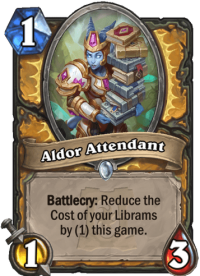
Paladin received one buff in the third Ashes of Outland balance patch, but that buff was arguably the biggest individual card change in the entire patch: Aldor Attendant was changed from a two-mana 2/3 into a one-mana 1/3.
Before this change, Paladin practically had no class one-drops: Imprisoned Sungill is a good card, but it really comes into play two turns after being played, and while Brazen Zealot looks like it can grow into a major threat, the meta can deal with a one-health minion in approximately one million ways. I tried. It dies. Fast.
Because Hearthstone is a heavily tempo-based game and getting on the board early is one of the best predictors for success, giving Paladin a one-drop has the potential to change the fortunes of the class. Indeed, statistics show that Aldor Attendant is now really, really good. But is it enough?
Pure Paladin
In the confusion of a fresh patch, some Pure Paladin decks were able to find success. For example, Rokmare piloted this list to #249 Legend in the first days after the patch:
- 1Aldor Attendant2

- 1Blessing of Wisdom1

- 1Imprisoned Sungill2

- 2Hand of A’dal2

- 2Libram of Wisdom2

- 2Murgur Murgurgle1

- 3Bronze Explorer2

- 3Consecration2

- 3Dragonrider Talritha1

- 3Underlight Angling Rod1

- 4Lightforged Zealot2

- 5Aldor Truthseeker2

- 5Amber Watcher2

- 5Blessed Champion1

- 5Libram of Justice2

- 7Lady Liadrin1

- 7Lightforged Crusader2

- 9Libram of Hope2

The power of turn one Aldor Attendant into Libram of Wisdom or Hand of A'dal is considerable, and when you find your Attendant for your opening hand, you can expect good things to follow.
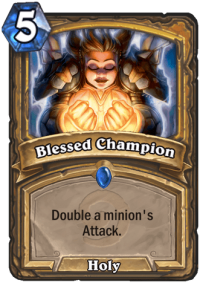
Other than that, the list is a fairly regular Pure Paladin in the way the archetype has been built from the start of Ashes of Outland. Librams, the Pure synergy cards Lightforged Zealot and Lightforged Crusader, and some dragons with Dragonrider Talritha.
The new twist in this list is Blessed Champion, which gives the deck additional reach, especially when combined with some zero-cost Libram of Wisdoms.
However, ultimately all these types of Pure Paladin lists have ended up at just about 50% win rate. It is not easy to find Aldor Attendant for turn one, nor is it easy to find your Librams or Dragonrider Talritha with hardly any card draw, and Lightforged Crusader usually gives you a handful of random junk. The archetype has the potential to succeed, but it lacks consistency.
Libram Paladin
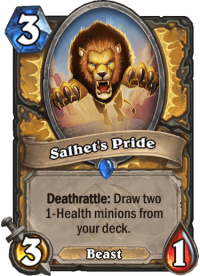
If Pure Paladin could succeed if it only was able to find its good cards, could we build a Paladin deck that can find good cards faster if we ditch the Pure ideology?
The card draw package was theorycrafted already before Saviors of Uldum, but the Libram package is what makes it worthwhile: Salhet's Pride, Loot Hoarder, Novice Engineer, and Bloodmage Thalnos form a strong cycle package that was tested in Holy Wrath Paladin in earlier expansions but was found lacking for that archetype. Now that there is also Murgur Murgurgle as an additional prize, the package seems more useful.
Ditching the Pure ideology also opens up Wild Pyromancer to the list of available cards, and that means some serious board-clearing power. Combine Wild Pyromancer with Libram of Justice or even just Libram of Wisdom, and boards will fall. My take on the archetype adds a single copy of Equality to the mix for even more reliable board clears.
This type of Paladin can draw through the deck rapidly and reliably, but it ends up lacking win conditions in some matchups. Aggro can still challenge it, but the worst thing is Rogue: when your win condition is Libram buffs, it is hard to survive Sap and Blackjack Stunner. If you go for multiple Libram of Hopes, you risk getting Flikked.
There have been several attempts to find a reliable win condition for the deck, and while Librams are useful in many matchups, the deck still needs something more. Exotic Mountseller seems to be the most reliable one at the moment ahead of Zephrys the Great and Dragonqueen Alexstrasza, but there are no clear late-game win conditions available for Paladin right now. Tirion Fordring‘s 6/6 stats for eight mana are simply obsolete in the current meta where you need around 20/20 stats at that point for a turn to be considered good.
In the end, Libram Paladin also finds itself at around the 50% win rate mark.
Pure Paladin, but Different
I believe there is still room for Paladin deck building after the Aldor Attendant buff. While most Pure Paladin lists repeat the same core, we could also try to take advantage of the fact that Paladin now has a strong one-drop. Therefore, I built this different take on Pure Paladin:
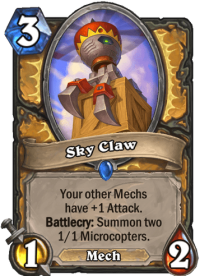
By ditching slow cards, it is now possible to build a Pure Paladin deck that goes for tempo and board control. Paladin has some good token-generation cards in Imprisoned Sungill, Air Raid, and Sky Claw (yes, it is still in Standard!) as well as sticky Reborn minions Micro Mummy and Shotbot. Instead of going for value, you can go for tempo and board control. Tokens also have great synergy with Libram of Wisdom as you can buff a token and trade, buff the next one and trade, and so on.
Weapons give the deck reach and tools to control the board and the Libram package provides board clears and healing without sacrificing tempo.
I had some success with this concept, but there are no large-scale statistics available. As a matter of fact, you cannot find a single deck that would even closely resemble this concept on HSReplay, for example. Maybe that shows that there are still niches left to explore when building Paladin decks.
Murloc Paladin
It’s not the buffs, it’s the nerfs. Surprisingly enough, the strongest Paladin deck in the current meta is the one that receives the least hype. Good old Murloc Paladin is putting up some decent numbers, we’re talking about 55%-58% win rate here, and those are far ahead of all the other Paladin competition.
This is the Murloc Paladin list I’d recommend right now. It was built more than a month ago according to statistics on HSReplay but I could not trace who came up with this exact build. It is almost the same as every other Murloc Paladin deck out there – how creative can you really be when you fill the deck with Murlocs – but its key differentiating characteristic is the double Consecration tech.
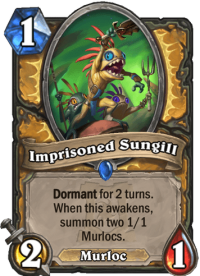
Sometimes you just want a bunch of low-health minions to die, and Consecration seems to help the archetype towards more consistent results: for example, having your Imprisoned Sungill wake up to a wide enemy board can be awkward, but a simple Consecration can make life good again. The main alternative to Consecration is Scalelord, but it often only helps you to keep your board and not come back from behind, so it’s anti-control tech whereas Consecration is anti-aggro/tempo tech.
Murloc Paladin puts up some truly impressive numbers in lower ranks, but its performance drops closer to the other Paladin archetypes in Diamond and Legend. Nonetheless, it remains the top choice of all the Paladin decks that have large sample sizes in all ranks at the moment.
Maybe Not Quite Good, but at Least Ok?
There is no doubt that the Aldor Attendant buff and the nerfs to other classes have improved Paladin’s relative position in the meta. However, the starting point was one of the worst that any class has ever been in, with hardly any decks able to reach even 50% win rate. Now, Libram Paladins are mostly just below 50%, Pure Paladins just above 50%, and Murloc Paladins have some climb-capable win rates at most ranks.
However, there is still room to explore new ways to build Paladin decks as the Token Pure Paladin deck in this article demonstrates. Whether any such decks can find long-term success is another matter, but classes that are perceived to be weak usually receive less attention in Hearthstone and therefore have the biggest potential for undiscovered improvements. Highlander Paladin, for example, is one relatively unexplored archetype that has not found any success yet, but that could perhaps be built in new ways.
I cannot recommend Paladin as an effective choice for climbing the ladder, but the balance changes have at least managed to breathe some life into the class so that enthusiasts can now play it without also having to enjoy losing over and over again.
Leave a Reply
You must be logged in to post a comment.























Very good article, thank you.
I managed to hit legend with Vicious Syndicate’s Pure Paladin list. If you can find yourself in a decent mini meta with Demon hunters and Hunters then you can do some good stuff.
As pointed out in the article the problem is rogue, it’s a horrible matchup.
I feel like we’re getting close to some really fun and cool decks with Paladin and I’m hoping they receive some good tools for the next expansion.
I really feel like Paladin would benefit from having their Classic and basic sets looked at and buffed.
HS Devs need to read this article. So good! 🙂
I really like Paladin but isn’t his time for now.
I’m playing Dragon Hunter. So pleasure, so consistent. <3
Which list ?
Do you still run the 1/1 boar after the nerf ?
Don’t run boras anymore.